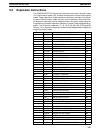
138
5-1 Notation
In the remainder of this manual, all instructions will be referred to by their mne-
monics. For example, the Output instruction will be called OUT; the AND Load
instruction, AND LD. If you’re not sure of the instruction a mnemonic is used for,
refer to Appendix B Programming Instructions.
If an instruction is assigned a function code, it will be given in parentheses after
the mnemonic. These function codes, which are 2-digit decimal numbers, are
used to input most instructions into the CPU Unit and are described briefly below
and in more detail in 4-7 Inputting, Modifying, and Checking the Program. A table
of instructions listed in order of function codes, is also provided in Appendix B.
An @ before a mnemonic indicates the differentiated version of that instruction.
Differentiated instructions are explained in Section 5-4.
5-2 Instruction Format
Most instructions have at least one or more operands associated with them. Op-
erands indicate or provide the data on which an instruction is to be performed.
These are sometimes input as the actual numeric values (i.e., as constants), but
are usually the addresses of data area words or bits that contain the data to be
used. A bit whose address is designated as an operand is called an operand bit;
a word whose address is designated as an operand is called an operand word. In
some instructions, the word address designated in an instruction indicates the
first of multiple words containing the desired data.
Each instruction requires one or more words in Program Memory. The first word
is the instruction word, which specifies the instruction and contains any definers
(described below) or operand bits required by the instruction. Other operands
required by the instruction are contained in following words, one operand per
word. Some instructions require up to four words.
A definer is an operand associated with an instruction and contained in the same
word as the instruction itself. These operands define the instruction rather than
telling what data it is to use. Examples of definers are TC numbers, which are
used in timer and counter instructions to create timers and counters, as well as
jump numbers (which define which Jump instruction is paired with which Jump
End instruction). Bit operands are also contained in the same word as the
instruction itself, although these are not considered definers.
5-3 Data Areas, Definer Values, and Flags
In this section, each instruction description includes its ladder diagram symbol,
the data areas that can be used by its operands, and the values that can be used
as definers. Details for the data areas are also specified by the operand names
and the type of data required for each operand (i.e., word or bit and, for words,
hexadecimal or BCD).
Not all addresses in the specified data areas are necessarily allowed for an oper-
and, e.g., if an operand requires two words, the last word in a data area cannot
be designated as the first word of the operand because all words for a single op-
erand must be within the same data area. Also, not all words in the SR and DM
areas are writeable as operands (see Section 3 Memory Areas for details.) Oth-
er specific limitations are given in a Limitations subsection. Refer to Section 3
Memory Areas for addressing conventions and the addresses of flags and con-
trol bits.
Data Areas, Definer Values, and Flags Section 5-3


















